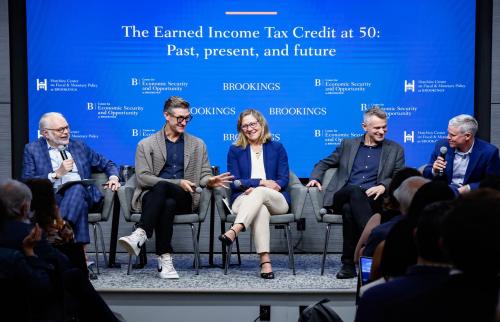Here’s a fact you’ve probably heard before: The U.S. is the only developed nation in the world without a national paid family leave policy. The Family and Medical Leave Act (FMLA)—signed into law by President Clinton in 1993—is the lone piece of federal legislation addressing workers’ access to parental, family, and medical leave, but it only provides workers with unpaid, job-protected leave.
Over the past year, a working group of experts from Brookings and AEI have joined together under a common assumption: It’s time to put partisan disagreements aside and make progress.
In early June, the working group published a major report toward that end, which outlines recommendations for a federal paid leave policy, evaluates existing proposals, and proposes a compromise proposal on paid parental leave, in particular.
The need for paid parental leave
The authors of the report make a strong case for why Americans need paid parental leave, in particular, arguing that a shift in the composition of the labor force has dramatically changed how working families spend their time. In 2016, 58 percent of mothers with children under one year old were in the labor force.
Not only would a paid leave program increase labor force participation rates by encouraging women to stay in the labor force when pregnant as opposed to dropping out entirely, it’s also been shown that children fare much better when mothers and fathers have access to paid parental leave.
Finally, Americans across party lines want paid leave. Polls show overwhelming support for paid family and medical leave, and that support is bipartisan with almost 71 percent of Republicans and 83 percent of Democrats in favor of paid parental leave.
Existing paid leave plans and proposals
Paid family leave is provided at the state level in only a handful of states. California, New Jersey, and Rhode Island all have existing plans in place, and policies will soon be implemented in the state of New York and the District of Columbia.
Tech companies such as Google and Netflix offer many months of paid leave to accommodate the needs of working parents in their organizations. But importantly, employer-provided paid leave is concentrated among high-income workers; a majority of those below median income received no pay while on leave.
At the federal level, three major proposals exist:
- The Family Act, sponsored by Rep. Rosa DeLauro (D-CT) and Sen. Kirsten Gillibrand (D-NY), would offer mothers and fathers (as well as caregivers and the seriously ill) up to $1,000 per week in wage reimbursement for up to 12 weeks of leave.
- President Trump’s paid leave policy would provide up to six weeks of leave, but there remains some uncertainty about much of the policy beyond that.
- The Strong Families Act, sponsored by Sen. Deb Fischer (R-NE) and cosponsored by Sens. Angus King (I-ME) and Marco Rubio (R-FL), would offer a tax credit to businesses that provide 100 percent wage reimbursement to employees for anywhere from two to 12 weeks.
The proposals discussed above reflect the diversity of options at the federal level, but they don’t begin to exhaust the possibilities for policy options. The challenge is balancing the generosity of a federal program with the costs associated with it. In weighing these options, the AEI-Brookings Working Group settled on a compromise plan that would be relatively targeted to ensure the lowest income workers most in need of a federal solution would be covered by the plan while also keeping costs down.
Time to compromise
It’s clear from the strong public support and the policy proposals from both parties that the time is right for a paid parental leave policy in the U.S. But even among the members of the AEI-Brookings Working Group, who each support some form a paid parental leave policy, there’s disagreement about what exactly that policy should look like. How generous should it be? Should it be targeted only to the poor or extended to the middle class? What’s the best way to pay for a federal policy? To help make progress despite disagreement, the Working Group agreed on five main elements that a paid parental leave program must include, suggesting a plain comprise of these elements could win bipartisan support.
According to members of the Working Group, a compromise plan would:
- Be available to both employed mothers and fathers (with strict eligibility requirements), so that working parents do not need to return to work within days of a child’s birth or adoption.
- Be budget neutral, splitting the costs of financing between a payroll tax and cutting government spending or tax expenditures elsewhere in a way that does not adversely affect low-income families.
- Keep the benefits relatively targeted and inexpensive by offering a 70 percent replacement rate up to a cap of $600 per week for a limited number of weeks (e.g. eight weeks).
- Include job protection.
- Require an independent study of the effects of paid family leave to ensure that such a policy is not having significant unintended consequences, such as crowding out existing plans or leading to discrimination.
Moving forward
There are still plenty of areas to improve when it comes to discussions around a paid family leave policy. The AEI-Brookings Working Group believes current cost estimates need improvement and that a more inclusive policy that covers all types of leave, including family and medical leave, deserves consideration. While the experts had their disagreements about the specific design of a paid leave program, they write “All of us believe that paid parental leave is an issue whose time has come. The U.S. is the only advanced country that provides no public support to new parents.”
The Brookings Institution is committed to quality, independence, and impact.
We are supported by a diverse array of funders. In line with our values and policies, each Brookings publication represents the sole views of its author(s).







Commentary
It’s time to make paid parental leave happen nationally, and here’s how to do it
June 16, 2017